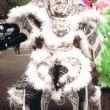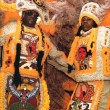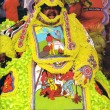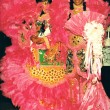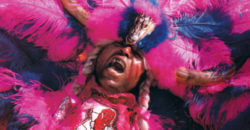Magazine
Contextual Portraits Mardi Gras Indians From An Insider’s View
Published: February 1, 2016
Last Updated: September 1, 2017
by Nash Porter
I was born in New Orleans and grew up in an Uptown community surrounded by African American cultural sights and sounds. As a little boy, I used to follow the Mardi Gras Indians all day and sometimes had a hard time finding my way back home. No matter how I talked about and marveled at the Indians, my grandmother, who raised me, would not even think about allowing me to mask. So I had to be content with just observing. However, as soon as I became an adult and moved away, I began taking snapshots of the Indians, mainly as a “show and tell” for friends wherever I lived.
While living in the San Francisco Bay Area, my interest in photography began to develop on a professional level. It was only after several years of making the annual trip home for Mardi Gras that I discovered my leaning towards cultural documentation. By this time, I had a photography studio. With encouragement from my mentor – M.J. Porter, an eminent photographer of New Orleans –I seriously began to document the Indians.
- Chief “Bo” Dollis, Wild Magnolias, 1985
- Chief Victor Harris, Fi-Yi-Yi, 1997
- Chief Larry Bannock & Queen, Golden Star Hunters, 2000
- Chief “Monk” Boudreaux, Golden Eagles, 2000
- Chief “Bo” Dean, Young Cheyenne, 2000
- Second Chief Cyril “Ironhorse”, Young Cheyenne, 2000
- Chief Walter Cook and his wife Angie, Creole Wild West, 1995
- Flag Boy Derrick Hulin, Wild Magnolias, 1986
My first exhibit on the Black Mardi Gras Indians, curated by E.J. Montgomery, was a one person show in 1975 at the Rainbow Sign Gallery in Berkeley, California. Although some of my other exhibits have included African-American blues and jazz musicians, everyday life in Senegal, rituals and celebrations in the African Diaspora, and an amalgam of flowers, my priority work over 30-plus years has been with the Indians. My familiarity with this street tradition and many of the participants who have given me entrance into their homes have allowed me to capture them at close range and to attempt to bring out the true essence and cultural flavor of this annual ritual. I have a tremendous amount of respect for the people who mask as Indians and since I am a part of this community I always want to represent them well. After reflecting and viewing thousands of my negatives over the years, I realized that because of my experience in portraiture, the majority of my photos were head and full-bodied portraits in context.
These gifted men and women, who have inspired me over the years with their artistry and dedication to the tradition, have certainly enriched my life. One of the gratifications of shooting the Black Indians has been the opportunity to meet once again and to renew friendships with people I first photographed decades ago, early in their years of masking Indian. I have seen children grow up in the tradition. These reunions are especially heartwarming because with some of them I can see how the years have enhanced their personal and artistic development and refined their craft. This is especially evident when I return to my darkroom to print and then begin to compare various years of several people masking. I get excited all over again! I photograph the Indians to document the vitality, diversity, and continuity of this Black New Orleans experience so the rest of the world can see what I see through the camera lens.
—–
Nash Porter is a photographer now living in Baton Rouge.

